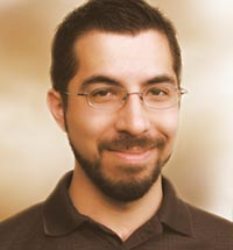Mar 13 2013
The Fannie and John Hertz Foundation applauds Hertz Fellow, Edward S. Boyden III, Associate Professor in the MIT Media Lab and at the McGovern Institute for Brain Research.
 Ed Boyden
Ed Boyden
Boyden is among six eminent scientists who will share the 1 million-euro prize, awarded for their development of optogenetics, a technology that makes it possible to control brain activity using light. The Brain Prize is awarded annually by the Denmark-based Grete Lundbeck Foundation for outstanding contributions to European neuroscience.
Boyden is recognized for ground-breaking research in collaboration with Karl Deisseroth at Stanford University. Their work builds on earlier discoveries by four European researchers: Ernst Bamber , Georg Nagel and Peter Hegemann in Germany and Gero Miesenbock , now in Oxford, U.K. The €1M prize will be shared equally by all six researchers for their work in optogenetics, viewed as one of the most impactful developments in neuroscience of the last decade.
The idea of using light to control brain activity was suggested by Francis Crick in 1999. Miesenbock performed a proof of concept demonstration in 2002, showing that light-sensitive proteins obtained from the eyes of fruit flies could be used to activate mammalian neurons. A further breakthrough was enabled by the discovery of channelrhodopsin-2 (ChR2), a light-activated ion channel from a common pond algal species that had been characterized by Hegemann in Martinsried and by Nagel and Bamberg in Frankfurt. The application of ChR2 to neuroscience was pioneered by Boyden and Deisseroth at Stanford University.
Recalling those early days, Boyden says, "Personally, the Hertz Fellowship allowed me to pursue several careers in parallel while a Stanford PhD student, working by day on motor learning (for which I won the Hertz Thesis Prize), and by night on developing optogenetic methods for controlling the brain with light. I was able to launch projects all over Stanford, working in an omnidisciplinary fashion. This would not have been possible without Hertz support. That was after I had received the Fellowship presumably to work at MIT on quantum computing. I had to inform the Hertz Foundation that I was moving on to Stanford's medical school to try to launch this field of neuroengineering. I only received encouragement."
In a collaboration that began when Boyden was a Stanford graduate student and Deisseroth a postdoctoral fellow (and now, a faculty member), they obtained the ChR2 gene from Nagel and Bamberg, expressed it in cultured neurons, and pulsed the dish with blue light to see whether it could trigger neural activity. The first experiment was performed in August 2004, and it worked first time; as Boyden recounted in a recent historical article, "serendipity had struck—the molecule was good enough in its wild-type form to be used in neurons right away."
They reported this result in 2005, in a landmark paper in Nature Neuroscience that has now been cited over 600 times. Their method, later dubbed "optogenetics," is now used by hundreds of labs worldwide and is also being explored for a wide range of potential therapeutic applications.
Over the past decade, Francis Crick 's dream has been transformed into the reality of a powerful and versatile technology. In 2010, optogenetics was named Method of the Year across all fields of science by the leading journal Nature Methods, and 'Breakthrough of the Decade' by the journal Science.
The reaction to these demonstrations of the effectiveness of optogenetics has been rapid and far-reaching. The potential medical applications are also exciting. Research is already underway to use optogenetic techniques to restore some sort of vision after age-related degeneration of the retina of the eye. And optogenetic methods, combined with fibre-optic probes, offer a possible sophisticated alternative to deep brain stimulation with metal electrodes for treatment of Parkinson's disease, intractable pain, depression and other psychiatric disorders.
Professor Colin Blakemore , Chairman of the Selection Committee for the Brain Prize said: "Optogenetic control of nerve cells is arguably the most important technical advance in neuroscience in the past 40 years. It offers a revolution in our understanding of the way in which circuits of neurons carry out complex functions, such as learning and controlling movement. And it could provide an entirely new approach to the restoration of function in blindness or brain degeneration, and to the treatment of conditions as varied as pain, depression, addiction and Parkinson's disease. The Brain Prize honors four European scientists who laid the foundations of optogenetics, and two young Americans who, in collaboration with the Europeans, launched the technology that is having such a huge impact in neuroscience."
Boyden's group at MIT has developed tools for analyzing and engineering brain circuits. Driven by the goal of optical control of targeted neurons, in 2000 Boyden and Deisseroth began to discuss using opsins to manipulate neural activity. In 2004 they established a collaboration with Nagel and Bamberg that led to a successful demonstration of opsin-mediated neural activation. His group continues to introduce optogenetic tool classes into neuroscience, including halorhodopsins (2007) and bacteriorhodopsins (2010) for optical neural silencing. They optimize these opsins for novel neuroscientific applications, and develop complementary technologies such as scalable neural recording technologies.
"Dr. Boyden is a fine representative of the extraordinary community of the Hertz Fellows," stated Dr. Jay Davis. "It's been our good fortune to receive his gracious support as a promoter of the Hertz Foundation and most recently, as a Hertz Fellowship candidate interviewer. Above all, it's a privilege to witness his brilliant career and to see it being rewarded in this way."